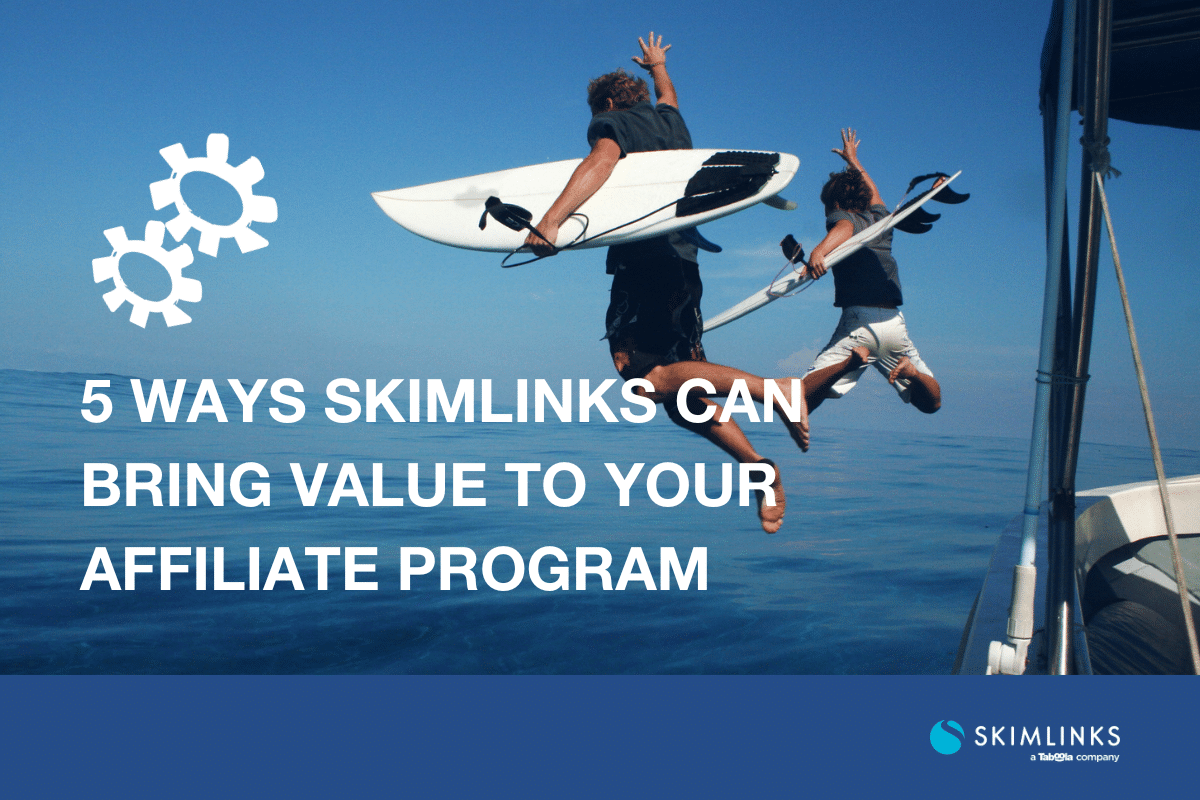How to Protect Your Affiliate Marketing Revenue From Google SGE
Posted 2 weeks ago by Adriana Harseva

Google Search Generative Experience (SGE) has caused anxiety amongst publishers and the affiliate marketing world, but it’s not time to run for the hills yet. There is still ample time to adapt your marketing strategy to protect your revenue from potential organic volume loss. In this article, we are looking into ways to diversify and maximize your traffic in order to reduce reliance on Google Search.
What is SGE?
Google Search Generative Experience (SGE) is the engine’s new approach to search results.
It uses generative artificial intelligence (AI) to provide users with quick and clear overviews of search topics without having to click on individual pages. As of April 2024, it’s only available in the US to users who have opted-in to participate through Google’s Search Lab on Chrome but a general rollout is expected to come later this year.
How will Google SGE affect publishers?
Commerce content publishers may see a decrease in traffic for some keywords, as SGE will shift some e-commerce transactions to happen directly on Google. For example a search for a commuter bike suitable for hills, will generate the following results, including short review, price comparison and suggested retailers:

It is too early, however, to give definitive answers on how Google SGE will affect search volumes and revenue for publishers. Some industry experts report that Google’s May rollout could slash publishers’ organic traffic by 20% to 60%, notes Adweek. A decrease in search traffic for publishers on the open web often translates to a decline in digital ad revenue. Marc McCollum, executive vice president of innovation at Raptive, which runs sales ads for a number of publishers, suggests the industry could face up to a $2 billion annual shortfall in ad revenues due to SGE’s impact
Others, however, have a more positive outlook. A data study, conducted by Malte Landwehr, Head of SEO at idealo, suggests that SGE will significantly damage the rankings of e-commerce sites, while elevating publishers. Landwehr’s findings included a table displaying the top 10 ‘winner and loser domains’ in the realm of SGE. It shows the organic rankings of various websites in search results and compares them to the rankings in SGE.
While there are no clear steps yet on how to mitigate the potential traffic loss, the shift toward SGE highlights the importance of adaptability and innovation in digital publishing. As platforms like Google continue to refine their algorithms and search experiences, the ability of publishers to anticipate changes and strategically pivot will be paramount.
Publishers should consider reevaluating their SEO strategies and diversify their traffic sources and invest in owned channels. The less a publisher needs to rely on a gatekeeper, the better.
How to maximize and diversify traffic
Build a strong brand
Building a strong brand is foundational to maximizing commerce content traffic and safeguarding revenue, especially in the face of updates like Google SGE. A distinctive and trusted brand stands out in a crowded marketplace, becoming a go-to source for consumers seeking reliable information and products. It’s about creating a memorable identity that resonates with your audience, fostering a sense of loyalty and community around your content. This involves consistent messaging, a recognizable visual identity, and delivering value that goes beyond the transactional—engaging stories, insightful advice, and genuine interactions. By investing in your brand, you make your platform indispensable. As search engines evolve, a strong brand becomes your anchor, maintaining visibility and engagement even as algorithms change. It’s your brand’s reputation and the trust you’ve built with your audience that will protect and propel your traffic, ensuring that regardless of how search experiences are reshaped, your content remains a preferred destination.
Focus on email marketing
If you’re not already collecting email addresses and using your list to increase affiliate sales, this should be your first main focus after reading this article. Owning your traffic channels is your strongest revenue shield against any Google algorithm fluctuations and any company changing its policies. Email is a powerful traffic source for affiliate marketing, despite the many alternatives. As the oldest online channel available, it’s considered one of the most effective ways to reach users and potential customers.
To start your mailing list, craft a great lead magnet, a free compelling resource (like a guide, checklist, masterclass, or a chance to win an exclusive prize.). Once your list is built, make sure you provide your subscribers with valuable content and don’t spam them.
Email marketing has strict regulations that vary by country. Make sure you comply with them to avoid legal issues.
Here are some tips to get the most out of email marketing:
- Never buy email lists. Build your own out of your target audience and readers interested in your content. Otherwise, your spam score will suffer and your emails won’t be delivered to your genuine subscribers
- Offer real value to your readers or they’ll unsubscribe quickly, or worse – report your domain as spam
- Segment your list to send targeted content relevant to your subscribers
- Review your email campaign metrics and KPIs to understand better your subscribers and how your list is performing
Rethink your SEO strategy
With Google SGE, search results will be more relevant and personalized, making search engine optimization techniques more complex. SEO specialists will then have to optimize the content to respond precisely to user queries.
There are many unknowns to what will work best, but based on what we know so far, here are some things to consider:
- GenAI loves summaries. Make sure you add an executive summary to long-form content
- Pros and cons are often cited in product reviews. Including this in your commerce content will increase your likelihood of being mentioned as a source.
- In your content strategy, focus on new topics/trends/events/news that were not part of the training data for SGE. That way, the systems need you as a source, and you are more likely to be included as a source.
- Great images are likely to have a positive impact on CTR, just like a good thumbnail on YouTube and attractive images in general. User-generated content or original images will work the best. Just using a product photo from a merchant’s website is unlikely to get you the click.
That being said, it’s more important to focus on things that have a negative impact on SEO today. While it’s important to stay vigilant for any new updates, especially when your traffic is strongly reliant on organic traffic, you shouldn’t let that distract you from what is happening right now. Instead, work on the things that you know will have an impact in the future.If you are from the EU or countries that might not get SGE immediately. Watch the impact in first markets and learn from that.
Focus on curation and expertise
Generative AI is strong in producing content at scale. But that content tends to be average and repetitive. If everyone was to use genAI for their content, we will be reading the same articles over and over again, and users will quickly start avoiding them. We don’t know yet how the SGE content will look like but based on the existing state of genAI, it’s likely that it will summarize existing content and lack originality.
Originality is the path to success. If your main competition becomes genAI, the way to win, is to focus on curation and expertise. The more content is out there, the more valuable it becomes for the user to have a publisher to rely on for quality content. Your brand voice and your expertise will be your strongest assets in a sea of repetitive content.
Expertise and experience are also two of the key components to the Google E-E-A-T concept that the search engine uses to evaluate which content will rank highest. The acronym stands for Experience, Expertise, Authoritativeness, and Trustworthiness. By focusing on original, expert, first-hand-experience content you have the chance to not only wow your readers and convert them to long haul followers, but win SERPs too.
Cement your social media presence
Solidifying your presence on social media is key to diversify your traffic. Gone are the days when Instagram and TikTok were optional marketing channels. Social media has a vast and diverse reach – 93% of Americans use some form of social media with 29% of consumers purchasing items on social media at least once a week. Social media comes with great competition, so in order to be successful, you need to have a strong brand, unique voice and content catered to the specific platform. Choosing the best social media platform for your commerce content depends on your niche, goals, content style, and budget. Each platform has unique features, audiences, and best practices. We’ve put together a quick checklist on what to consider before deciding which platform to invest in:
| Criteria | What to consider |
| Target Audience | ✔️ Does your target audience use the platform?
✔️ Are they in the majority, or just a tiny fraction of the total audience? |
| Top-performing content types | ✔️ Can you create the type of content that performs best on the platform?
✔️ Does that format fit the products you’re promoting? |
| Competition | ✔️ Are other publishers in your niche using the platform?
✔️ How saturated is the platforms with competitors in your niche? ✔️ How do their audiences compare to yours? ✔️ Can you create original content that’s at least as good as theirs? |
| Suitability for affiliate marketing | ✔️ How easy is it to add affiliate links?
✔️ Does the platform deprioritize content with external links? ✔️ Are there limitations on where you can post those links? |
Don’t overlook Pinterest
Pinterest is a dark horse when it comes to social media affiliate marketing. It is not the first social media platform that comes to mind but it has an exceptionally large user-base and those on the platform are very engaged with the content. Unlike other social networks where users go just to be entertained, Pinterest is about finding inspiration and saving it in Pins. Millions come to Pinterest to plan new projects and discover products, using it as a search engine.
It is also a great way to engage with the younger generation, who are often less likely to use Google Search or read traditional digital media. Gen Z is the fastest growing audience on Pinterest, representing over 40% of the platform’s global monthly active users, says Rachel Hardy, Pinterest’s director of consumer product marketing. Pinterest is a high ranking website, meaning relevant content on the platform often sits higher on the Search Engine Results Page (SERP).
The only downside, however, is that people looking for inspiration are usually not ready to buy. To engage your audience on the platform and convince them to take the next step, you’ll have to offer more than standard product images. Your focus should be on quality content and building your Pinterest profile first, and not just using it as a gateway to drive traffic and affiliate sales. Quality content and authenticity is highly valuable on any platform. Always post your own pins, create your own board, interact genuinely with other users and make sure you are bringing value.
Pinterest does allow users to include affiliate links directly in their pins but there are strict rules about what you can and can’t do. Make sure you are familiar with their guidelines before you start posting affiliate links. To start using your affiliate links on Pinterest, you first need to have a Business account. Then simply create a pin of your own and supply your affiliate link as the URL for that pin. Alternatively, you can link to the commerce content on your website.
Leverage strategic partnerships
Collaborations and partnerships enable brands to leverage mutual strengths and audiences, offering an efficient path to expand reach and innovate. By teaming up with influencers, complementary businesses, or even competitors, brands can pool resources to create unique content, cross-promotions, or events. This strategy not only broadens exposure but also fosters creativity, enabling partners to tap into new markets and enhance brand perception effectively. The technique of guest blogging is a tried and true method for generating affiliate marketing traffic that has stood the test of time.
Build an app
Investing into a dedicated app to serve content directly on your users’ devices can be a powerful long-term strategic approach to reduce your reliance on SEO. An app offers a unique ecosystem where users can engage with your content in a personalized and interactive environment, free from the constraints and competition of search engine rankings. It allows for the implementation of push notifications, encouraging real-time engagement and keeping your audience updated with the latest content or offerings. Furthermore, an app can harness user data to deliver tailored content, improving user experience and fostering loyalty. Building an app is a significant investment, but it can strengthen your brand’s digital infrastructure, providing a stable platform for growth and engagement independent of external search dynamics.
The key takeaway?
Don’t become overly fixated on SGE. It’s too early to know the exact impact it will have on affiliate marketing and commerce traffic. Focus instead on the strategies listed in this blog to build a sustainable traffic model that can endure the ever-changing online landscape.
We’ll keep track on the future developments in the area and keep you updated.

